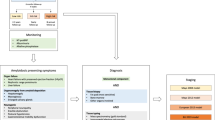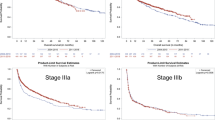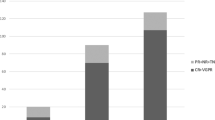Abstract
The natural history of multiple myeloma (MM) was revolutionized by the introduction of haematopoietic stem cell transplantation to the treatment armamentarium of this disease. Defined subgroups of MM patients (such as the elderly or dialysis-dependent) have required an individualized approach in order to minimize the transplant-related mortality. Little, however, is known about the management of 12–30% of MM patients with coexistent AL amyloidosis as the amyloidopathy is often overlooked and when recognized these patients commonly are excluded from clinical trials. While occult amyloidosis appears to have no impact on the toxicity and outcome of MM patients, the presence of symptomatic amyloidopathy clearly worsens their prognosis. Use of induction chemotherapy drugs that can cause further damage to the heart (Adriamycin), nervous system (Vincristine) or kidneys should be avoided as should lengthy delays in proceeding to autograft. Further, refining the transplant eligibility criteria for this subgroup of patients with co-existent amyloidopathy to include the number of organs involved and the degree of cardiac involvement (NYHA class, Troponins and NT-pro-BNP levels) along with melphalan dose-adjustment will minimize the treatment-related toxicity and mortality and possibly allow a reversal of the organ damage induced by the amyloidogenic light chain.
This is a preview of subscription content, access via your institution
Access options
Subscribe to this journal
Receive 12 print issues and online access
$259.00 per year
only $21.58 per issue
Buy this article
- Purchase on Springer Link
- Instant access to full article PDF
Prices may be subject to local taxes which are calculated during checkout
Similar content being viewed by others
References
Rajkumar SV, Gertz MA, Kyle RA . Primary systemic amyloidosis with delayed progression to multiple myeloma. Cancer 1998; 82: 1501–1505.
Gertz MA, Lacy MQ, Dispenzieri A . Amyloidosis. Hematol Oncol Clin North Am 1999; 13: 1211–1233, ix.
Desikan KR, Dhodapkar MV, Hough A, Waldron T, Jagannath S, Siegel D et al. Incidence and impact of light chain associated (AL) amyloidosis on the prognosis of patients with multiple myeloma treated with autologous transplantation. Leuk Lymphoma 1997; 27: 315–319.
Phillips GL, Meisenberg B, Reece DE, Adams VR, Badros A, Brunner J et al. Amifostine and autologous hematopoietic stem cell support of escalating-dose melphalan: a phase I study. Biol Blood Marrow Transplant 2004; 10: 473–483.
Moreau P, Facon T, Attal M, Hulin C, Michallet M, Maloisel F et al. Comparison of 200 mg/m(2) melphalan and 8 Gy total body irradiation plus 140 mg/m(2) melphalan as conditioning regimens for peripheral blood stem cell transplantation in patients with newly diagnosed multiple myeloma: final analysis of the Intergroupe Francophone du Myelome 9502 randomized trial. Blood 2002; 99: 731–735.
Comenzo RL, Gertz MA . Autologous stem cell transplantation for primary systemic amyloidosis. Blood 2002; 99: 4276–4282.
Palladini G, Malamani G, Co F, Pistorio A, Recusani F, Anesi E et al. Holter monitoring in AL amyloidosis: prognostic implications. Pacing Clin Electrophysiol 2001; 24: 1228–1233.
Palladini G, Perfetti V, Perlini S, Obici L, Lavatelli F, Caccialanza R et al. The combination of thalidomide and intermediate-dose dexamethasone is an effective but toxic treatment for patients with primary amyloidosis (AL). Blood 2005; 105: 2949–2951.
Merlini G, Bellotti V . Molecular mechanisms of amyloidosis. N Engl J Med 2003; 349: 583–596.
Paccalin M, Hachulla E, Cazalet C, Tricot L, Carreiro M, Rubi M et al. Localized amyloidosis: a survey of 35 French cases. Amyloid 2005; 12: 239–245.
Gertz MA, Kyle RA, Greipp PR . The plasma cell labeling index: a valuable tool in primary systemic amyloidosis. Blood 1989; 74: 1108–1111.
Perfetti V, Bellotti V, Garini P, Zorzoli I, Rovati B, Marinone MG et al. AL amyloidosis. Characterization of amyloidogenic cells by anti-idiotypic monoclonal antibodies. Lab Invest 1994; 71: 853–861.
Perfetti V, Ubbiali P, Magni M, Colli VM, Casarini S, Matteucci P et al. Cells with clonal light chains are present in peripheral blood at diagnosis and in apheretic stem cell harvests of primary amyloidosis. Bone Marrow Transplant 1999; 23: 323–327.
Fonseca R, Ahmann GJ, Jalal SM, Dewald GW, Larson DR, Therneau TM et al. Chromosomal abnormalities in systemic amyloidosis. Br J Haematol 1998; 103: 704–710.
Hayman SR, Bailey RJ, Jalal SM, Ahmann GJ, Dispenzieri A, Gertz MA et al. Translocations involving the immunoglobulin heavy-chain locus are possible early genetic events in patients with primary systemic amyloidosis. Blood 2001; 98: 2266–2268.
Perfetti V, Coluccia AM, Intini D, Malgeri U, Vignarelli MC, Casarini S et al. Translocation T(4;14)(p16.3;q32) is a recurrent genetic lesion in primary amyloidosis. Am J Pathol 2001; 158: 1599–1603.
Bergsagel PL, Kuehl WM, Zhan F, Sawyer J, Barlogie B, Shaughnessy Jr J . Cyclin D dysregulation: an early and unifying pathogenic event in multiple myeloma. Blood 2005; 106: 296–303.
Kuehl WM, Bergsagel PL . Early genetic events provide the basis for a clinical classification of multiple myeloma. Hematology (Am Soc Hematol Educ Program) 2005, 346–352.
Abraham RS, Ballman KV, Dispenzieri A, Grill DE, Manske MK, Price-Troska TL et al. Functional gene expression analysis of clonal plasma cells identifies a unique molecular profile for light chain amyloidosis. Blood 2005; 105: 794–803.
Haubitz M, Peest D . Myeloma--new approaches to combined nephrological-haematological management. Nephrol Dial Transplant 2006; 21: 582–590.
McElwain TJ, Powles RL . High-dose intravenous melphalan for plasma-cell leukaemia and myeloma. Lancet 1983; 2: 822–824.
Attal M, Harousseau JL, Stoppa AM, Sotto JJ, Fuzibet JG, Rossi JF et al. A prospective, randomized trial of autologous bone marrow transplantation and chemotherapy in multiple myeloma. Intergroupe Francais du Myelome. N Engl J Med 1996; 335: 91–97.
Child JA, Morgan GJ, Davies FE, Owen RG, Bell SE, Hawkins K et al. High-dose chemotherapy with hematopoietic stem-cell rescue for multiple myeloma. N Engl J Med 2003; 348: 1875–1883.
Barlogie B, Kyle RA, Anderson KC, Greipp PR, Lazarus HM, Hurd DD et al. Standard chemotherapy compared with high-dose chemoradiotherapy for multiple myeloma: final results of phase III US Intergroup Trial S9321. J Clin Oncol 2006; 24: 929–936.
Fermand JP, Katsahian S, Divine M, Leblond V, Dreyfus F, Macro M et al. High-dose therapy and autologous blood stem-cell transplantation compared with conventional treatment in myeloma patients aged 55 to 65 years: long-term results of a randomized control trial from the Group Myelome-Autogreffe. J Clin Oncol 2005; 23: 9227–9233.
Blade J, Rosinol L, Sureda A, Ribera JM, az-Mediavilla J, Garcia-Larana J et al. High-dose therapy intensification compared with continued standard chemotherapy in multiple myeloma patients responding to the initial chemotherapy: long-term results from a prospective randomized trial from the Spanish cooperative group PETHEMA. Blood 2005; 106: 3755–3759.
Attal M, Harousseau JL, Facon T, Guilhot F, Doyen C, Fuzibet JG et al. Single versus double autologous stem-cell transplantation for multiple myeloma. N Engl J Med 2003; 349: 2495–2502.
Cavo M . Update on high dose therapy – Italian studies. Haematologica 2005; 90: 39 (abstract PL8.04).
Kyle RA, Gertz MA, Greipp PR, Witzig TE, Lust JA, Lacy MQ et al. A trial of three regimens for primary amyloidosis: colchicine alone, melphalan and prednisone, and melphalan, prednisone, and colchicine. N Engl J Med 1997; 336: 1202–1207.
Comenzo RL, Vosburgh E, Falk RH, Sanchorawala V, Reisinger J, Dubrey S et al. Dose-intensive melphalan with blood stem-cell support for the treatment of AL (amyloid light-chain) amyloidosis: survival and responses in 25 patients. Blood 1998; 91: 3662–3670.
Gertz MA, Lacy MQ, Dispenzieri A, Ansell SM, Elliott MA, Gastineau DA et al. Risk-adjusted manipulation of melphalan dose before stem cell transplantation in patients with amyloidosis is associated with a lower response rate. Bone Marrow Transplant 2004; 34: 1025–1031.
Mollee PN, Wechalekar AD, Pereira DL, Franke N, Reece D, Chen C et al. Autologous stem cell transplantation in primary systemic amyloidosis: the impact of selection criteria on outcome. Bone Marrow Transplant 2004; 33: 271–277.
Perz JB, Schonland SO, Hundemer M, Kristen AV, Dengler TJ, Zeier M et al. High-dose melphalan with autologous stem cell transplantation after VAD induction chemotherapy for treatment of amyloid light chain amyloidosis: a single centre prospective phase II study. Br J Haematol 2004; 127: 543–551.
Skinner M, Sanchorawala V, Seldin DC, Dember LM, Falk RH, Berk JL et al. High-dose melphalan and autologous stem-cell transplantation in patients with AL amyloidosis: an 8-year study. Ann Intern Med 2004; 140: 85–93.
Moreau P, Leblond V, Bourquelot P, Facon T, Huynh A, Caillot D et al. Prognostic factors for survival and response after high-dose therapy and autologous stem cell transplantation in systemic AL amyloidosis: a report on 21 patients. Br J Haematol 1998; 101: 766–769.
Gertz MA, Blood E, Vesole DH, Abonour R, Lazarus HM, Greipp PR . A multicenter phase 2 trial of stem cell transplantation for immunoglobulin light-chain amyloidosis (E4A97): an Eastern Cooperative Oncology Group Study. Bone Marrow Transplant 2004; 34: 149–154.
Chow LQ, Bahlis N, Russell J, Chaudhry A, Morris D, Brown C et al. Autologous transplantation for primary systemic AL amyloidosis is feasible outside a major amyloidosis referral centre: the Calgary BMT Program experience. Bone Marrow Transplant 2005; 36: 591–596.
Schonland SO, Perz JB, Hundemer M, Hegenbart U, Kristen AV, Hund E et al. Indications for high-dose chemotherapy with autologous stem cell support in patients with systemic amyloid light chain amyloidosis. Transplantation 2005; 80: S160–S163.
Gillmore J . High dose melphalan and stem cell rescue for AL amyloidosis. In: Kyle RA, Gertz MA (eds). Amyloidand Amyloidosis. Parthenon Publishing: Pearl River, NY, 1999, p 102.
Perz JB, Rahemtulla A, Giles C, Szydlo RM, Davis J, Gopaul D et al. Long-term outcome of high-dose melphalan and autologous stem cell transplantation for AL amyloidosis. Bone Marrow Transplant 2006; 37: 937–943.
Vesole D, Perez W, Reece D, Akasheh M, Horowitz M, Bredeson C . High dose therapy with autologous hematopoietic stem cell transplantation (HSCT) for patients with primary systemic amyloidosis (AL): results from the autologous blood and marrow transplant registry (ABMTR). Blood 2003; 102: (abstract 402).
Dispenzieri A, Kyle RA, Lacy MQ, Therneau TM, Larson DR, Plevak MF et al. Superior survival in primary systemic amyloidosis patients undergoing peripheral blood stem cell transplantation: a case-control study. Blood 2004; 103: 3960–3963.
Jaccard A, Moreau P, Leblond V, Leleu X, Benboubker L, Hermine O et al. Autologous stem cell transplantation (ASCT) versus oral melphalan and high-dose dexamethasone in patients with AL (Primary) amyloidosis: results of the french multicentric randomized trial (MAG and IFM Intergroup). Blood 2005; 106: 127a (abstract 421).
Dispenzieri A, Gertz MA, Kyle RA, Lacy MQ, Burritt MF, Therneau TM et al. Prognostication of survival using cardiac troponins and N-terminal pro-brain natriuretic peptide in patients with primary systemic amyloidosis undergoing peripheral blood stem cell transplantation. Blood 2004; 104: 1881–1887.
Dispenzieri A, Gertz MA, Kyle RA, Lacy MQ, Burritt MF, Therneau TM et al. Serum cardiac troponins and N-terminal pro-brain natriuretic peptide: a staging system for primary systemic amyloidosis. J Clin Oncol 2004; 22: 3751–3757.
Pardanani A, Witzig TE, Schroeder G, McElroy EA, Fonseca R, Dispenzieri A et al. Circulating peripheral blood plasma cells as a prognostic indicator in patients with primary systemic amyloidosis. Blood 2003; 101: 827–830.
Powles R, Sirohi B, Kulkarni S, Treleaven J, Rudin C, Sankpal S et al. Collection of peripheral blood stem cells in newly diagnosed myeloma patients without any prior cytoreductive therapy: the first step towards an ‘operational cure’? Bone Marrow Transplant 2002; 30: 479–484.
Singhal S, Powles R, Sirohi B, Treleaven J, Kulkarni S, Mehta J . Response to induction chemotherapy is not essential to obtain survival benefit from high-dose melphalan and autotransplantation in myeloma. Bone Marrow Transplant 2002; 30: 673–679.
O'Shea D, Giles C, Terpos E, Perz J, Politou M, Sana V et al. Predictive factors for survival in myeloma patients who undergo autologous stem cell transplantation: a single-centre experience in 211 patients. Bone Marrow Transplant 2006; 37: 731–737.
Stewart AK, Vescio R, Schiller G, Ballester O, Noga S, Rugo H et al. Purging of autologous peripheral-blood stem cells using CD34 selection does not improve overall or progression-free survival after high-dose chemotherapy for multiple myeloma: results of a multicenter randomized controlled trial. J Clin Oncol 2001; 19: 3771–3779.
Barbui AM, Galli M, Dotti G, Belli N, Borleri G, Gritti G et al. Negative selection of peripheral blood stem cells to support a tandem autologous transplantation programme in multiple myeloma. Br J Haematol 2002; 116: 202–210.
Sanchorawala V, Wright DG, Seldin DC, Falk RH, Finn KT, Dember LM et al. High-dose intravenous melphalan and autologous stem cell transplantation as initial therapy or following two cycles of oral chemotherapy for the treatment of AL amyloidosis: results of a prospective randomized trial. Bone Marrow Transplant 2004; 33: 381–388.
Author information
Authors and Affiliations
Corresponding author
Rights and permissions
About this article
Cite this article
Bahlis, N., Lazarus, H. Multiple myeloma-associated AL amyloidosis: is a distinctive therapeutic approach warranted?. Bone Marrow Transplant 38, 7–15 (2006). https://doi.org/10.1038/sj.bmt.1705395
Received:
Accepted:
Published:
Issue Date:
DOI: https://doi.org/10.1038/sj.bmt.1705395
Keywords
This article is cited by
-
Cerebral Infarction as the First Manifestation of Multiple Myeloma and AL Amyloidosis: a Case Report
SN Comprehensive Clinical Medicine (2023)
-
Marked progress in AL amyloidosis survival: a 40-year longitudinal natural history study
Blood Cancer Journal (2021)
-
Series of myocardial FDG uptake requiring considerations of myocardial abnormalities in FDG-PET/CT
Japanese Journal of Radiology (2021)
-
Updates in the Diagnosis and Management of AL Amyloidosis
Current Hematologic Malignancy Reports (2020)
-
Approach to the Diagnosis of Amyloidosis
Indian Journal of Hematology and Blood Transfusion (2020)



